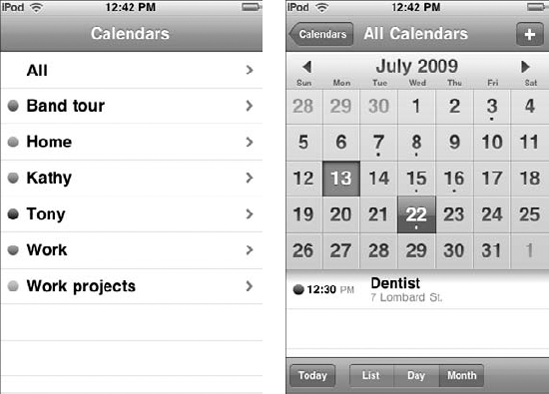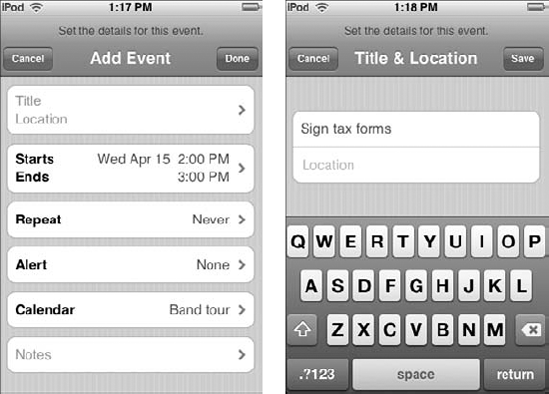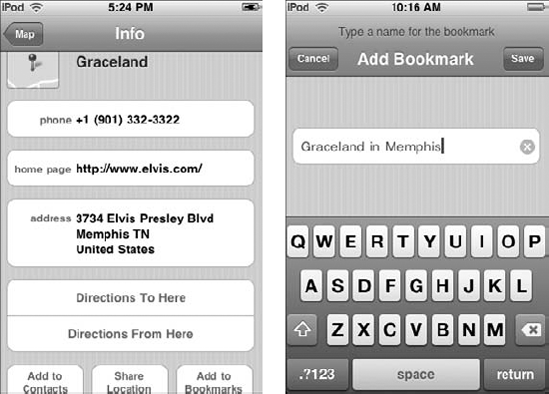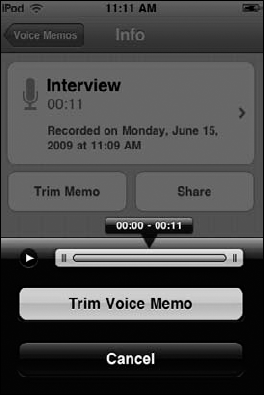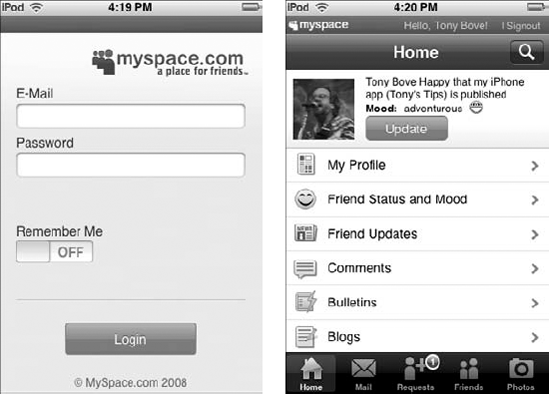In This Chapter
Checking your calendar and entering events
Entering and sorting your contacts
Using the Maps app to find locations on an iPod touch or iPhone
Keeping track of stocks and weather on an iPod touch or iPhone
Recording voice memos
Connecting to social networks on an iPod touch or iPhone
As John Lennon once sang, "Life is what happens to you when you're busy making other plans." And while life happens to you in real time, you can consult your iPod or iPhone calendar to view your appointments, look up friends in your list of contacts, and record voice memos on what to do next. On an iPod touch or iPhone, you can change appointments in the calendar and contact your contacts, as I describe in this chapter.
The iPod classic and iPod nano are supplied with "extras" (in the Extras menu) such as Calendars, Contacts, and Voice Memos, as well as "click wheel" Games, and you can find more in the iTunes Store that you can download. The iPod touch and iPhone, on the other hand, can run many thousands of apps available in the App Store. (See Chapter 7 for details on downloading from the iTunes Store and App Store.) This chapter shows you how to use the Calendars, Contacts, and Voice Memos extras on an iPod classic or nano, as well as how to use the Calendar, Contacts, and Voice Memos apps supplied with your iPod touch or iPhone.
Your iPod touch or iPhone can also find almost anything on Earth, even itself, and show the location on a map or satellite picture. And although you can't harness the forces of nature, or even the influences that drive Wall Street, you can use your iPod touch or iPhone to make better guesses about the weather and the stock market — find out how in this chapter.
To socialize and stay in contact with friends, relatives, and associates, you can use social networks such as Facebook and MySpace to share photos, thoughts, links, and profile information. The App Store offers social networking apps that link you directly to these networks and to messaging sites such as Twitter. You'll find all this and more in this chapter on your social life with iPod touch.
Note
To find out how to sync your iPod classic or nano with "click wheel" Games from the iTunes Store, and to play those games, visit this book's companion Web site.
The calendar in your iPod or iPhone isn't just for looking up dates (though it's quite good at that). If you see a blank calendar, it means that you need to synchronize your iPod or iPhone with your calendar files from iCal (Mac) or Outlook (Windows), or from MobileMe, as I describe in Chapter 10.
On an iPod touch or iPhone, tap Calendar on the Home screen. Here's what happens:
If this is your first visit to the Calendar app and you've synchronized multiple calendars to your iPod touch or iPhone, a list of your calendars appears (see Figure 21-1, left side). Tap All at the top to view all calendars merged into one or tap a specific calendar to see only that calendar. The calendar appears in a monthly view by default (see Figure 21-1, right side).
If you opened Calendar before, the app shows the calendar and view opened previously.
Tap any day to see the events on that day, which are displayed below the calendar view in a list.
Tap the List, Day, or Month button to change the calendar view to a list of events, a full day of scheduled appointments, or a month view, respectively. If you roam around from day to day or month to month, tap the Today button in the lower-left corner of the display to see the calendar for today.
On an iPod nano or iPod classic, choose Extras
Change happens, and you'll want to change your schedule or even add new events as you learn about them. Although you can enter appointments and events on your computer and sync them with your iPod touch or iPhone, as I point out in Chapter 10, you can also enter and change appointments and events directly in your iPod touch or iPhone and keep changes and additions synced with your computer.
To add an event, follow these steps:
Open the Calendar app as described earlier.
The Calendar app opens. Either the Calendar screen appears (refer to Figure 21-1, right side), or if you have multiple calendars, the list of calendars appears (refer to Figure 21-1, left side) — in which case you need to tap a calendar to see the Calendar screen.
Tap the plus (+) sign in the upper-right corner of the Calendar screen.
The Add Event screen appears, as shown in Figure 21-2 (left side).
Tap the Title/Location button, and enter the event's title and location using the on-screen keyboard.
The Title and Location fields appear along with the on-screen keyboard, as shown in Figure 21-2 (right side).
Tap Save in the upper-right corner to save the entry (or Cancel in the upper-left corner to cancel the entry).
The Add Event screen appears again for selecting more options, as shown in Figure 21-3 (left side).
Tap the Starts/Ends button to enter the starting and ending times and dates.
The Start & End screen appears, as shown in Figure 21-3 (right side), with a slot-machine-style number wheel to select the date and time.
Tap the Starts button and select the date and time, or tap the Off button for All-Day to turn on the All-Day option.
Slide your finger up and down the slot-machine-style number wheel to select the date and time. If you turn on the All-Day option, the number wheel changes to show only dates; select a date for the all-day event and skip the next step.
Tap the Ends button, and select the date and time as you did in Step 6.
Tap Save in the upper-right corner to save the entry (or Cancel in the upper-left corner to cancel the entry).
The Add Event screen appears again for selecting more options (refer to Figure 21-3, left side).
(Optional) Set the event to repeat by tapping Repeat and selecting a repeat time; then tap Save (or Cancel).
You can set the event to repeat every day, every week, every two weeks, every month, or every year (or Never, to not repeat). After you tap Save or Cancel, the Add Event screen appears again for selecting more options.
(Optional) Set an alert for a time before the event by tapping Alert and choosing an alert time; then tap Save (or Cancel).
You can set the alert to occur from five minutes to two days before the event. You can also set a second alert time in case you miss the first one. After you tap Save or Cancel, the Add Event screen appears again for selecting more options.
(Optional) If you have multiple calendars synced with your iPod touch or iPhone, you can change the calendar for the event by tapping Calendar and choosing a calendar.
The Calendars screen appears with a list of your calendars. Tap a calendar's name to choose it. After you tap Save or Cancel, the Add Event screen appears again for changing event options.
(Optional) Enter notes about the event by tapping Notes and using the on-screen keyboard to type notes.
The Notes field appears along with the keyboard so that you can type your notes. After you tap Save or Cancel, the Add Event screen appears again for changing event options.
Tap Done in the upper-right corner of the Add Event screen to save the event (or Cancel in the upper-left corner to cancel the event).
The new event now appears in your calendar in the lower portion of the Calendar screen when you select the day (refer to Figure 21-1, right side).
To edit an event, tap the event in the lower portion of the Calendar screen and then tap Edit in the upper-right corner of the Event screen. The event information appears and is ready for editing or deleting. To edit the event information, follow Steps 3-13 in this section.
If the calendar events you synced from your computer include alarms, you can turn on your iPod classic or iPod nano calendar alarm so that it beeps for those events. Choose Extras
On an iPod touch or iPhone, you can set alerts for meeting invitations and choose how many weeks of events to sync back to (to clear out old events). Choose Settings

Figure 21-4. The Contacts and Calendars sections for settings (left) and the Time Zone setting (right).
To set the option for how far back in time to sync your calendar events, tap Sync and choose a period of time (such as Events 2 Weeks Back).
If you have a Microsoft Exchange account set up with Calendars enabled, you can receive and respond to meeting invitations from others in your organization that also use Exchange. To set a sound as an alert for receiving a meeting invitation, tap the Off button for New Invitation Alerts to turn it on.
You can also turn time zone support on or off. When time zone support is on, event dates and times are displayed in the time zone of the city you selected. When time zone support is off, events are displayed in the time zone of your current location as determined by the network time. You might want to turn it on and select your home city so that dates and times are displayed as if you were in your home city, rather than where you actually are. For example, if you live in San Francisco and you're visiting New York, turning on time zone support and selecting San Francisco keeps the dates and times in your calendars on San Francisco time. Otherwise, they would switch to New York time.
To turn on time zone support, tap Time Zone Support, and on the Time Zone Support screen (refer to Figure 21-4, right side), tap Off to turn on time zone support (or tap On to turn it off). Then tap Time Zone and enter the name of a major city. As you type, city names are suggested based on what you've typed. Select the city to return to the Time Zone Support screen and then tap the Mail button in the upper-left corner to return to the settings screen — or, if you're finished making changes, press the physical Home button to leave settings altogether and return to the Home screen.
Tip
You can set your iPod touch or iPhone to play a beeping sound for your calendar alert. Choose Settings
The bits of information that you're most likely to need on the road are people's names, addresses, and phone numbers. An iPod or iPhone can store that stuff (in the Contacts format) right alongside your music. To see how to sync your personal contacts info on your computer with the info on your iPod or iPhone, check out Chapter 10.
To view contacts on an iPod touch or iPhone, tap the Contacts icon on the Home screen. The All Contacts screen appears. If you've organized contacts into groups, you can tap the Groups button in the upper-left corner of the screen to show the Groups screen, and then tap a group to see just that group, or tap All Contacts to return to the All Contacts screen.
The contact list is sorted automatically in alphabetical order by last name (in bold) but displayed so that the first name comes first, as shown in Figure 21-5 (left side). Scroll the list of contacts with your finger or tap a letter of the alphabet along the right side to go directly to names that begin with that letter. Then tap a contact to see that person's info screen.

Figure 21-5. Scroll the alphabetical list or tap a letter along the right side (left) or search by typing part of a name (right).
The contact's info screen shows all the information about reaching that contact. Tap an e-mail address to bring up the Mail app and send an e-mail to that contact. Tap a Web site address to load that page into Safari. Tap a physical address (with a street address) to bring up the Maps app and locate the contact on the map.
To view a contact on an iPod classic or iPod nano, choose Extras
You can change which way the contacts sort so that you can look up people by their first names (which can be time-consuming with so many friends named Elvis).
On an iPod touch or iPhone, choose Settings
First, Last: Sorts the contact list by first name, followed by the last name, so that Brian Jones sorts under the letter B for Brian (after Brian Auger but before Brian Wilson).
Last, First: Sorts the contacts by last name, followed by the first name, so that Brian Jones sorts under the letter J for Jones. (Jones, Brian appears after Jones, Alice but before Jones, Norah.)
On an iPod nano or iPod classic, choose Settings
First: Sorts the contact list by first name, followed by the last name.
Last: Sorts the contacts by last name, followed by the first name.
You can also change the way contacts are listed on an iPod touch or iPhone — with either their first names followed by their last names or their last names followed by their first names — regardless of how you sort them. Choose Settings
First, Last: Displays the contacts list by first name and then last name, as in Paul McCartney.
Last, First: Displays the contacts list by last name followed by a comma and the first name, as in McCartney, Paul.
Can't remember the person's full name or last name? You can search for any part of a person's name in Contacts on an iPod touch or iPhone by tapping the Search entry field at the very top of the list of contacts. The search-entry field appears with the keyboard (see Figure 21-5, right side), and suggestions appear as you type.
Tap a suggested name to view the Contacts record for that person. You can then edit or delete the contact information.
You meet people all the time, so why not enter their information immediately? You can enter new contacts, edit existing contacts, and even delete contacts directly on your iPod touch or iPhone, and keep your contacts in sync with your computer. (For sync info, see Chapter 10.)
To add a contact, follow these steps:
Tap the Contacts icon on the Home screen.
Tap the plus (+) sign in the upper-right corner of the Contacts display.
The New Contact screen appears, as shown in Figure 21-6 (left side).
Tap the First Last button and enter the contact's first and last name, as well as the company name, using the keyboard.
The First, Last, and Company fields appear on the Add Name screen (see Figure 21-6, right side) along with the keyboard.
Tap Save in the upper-right corner of the Add Name screen to save the name (or Cancel in the upper-left corner to cancel the name).
The New Contact screen appears again for selecting more options (refer to Figure 21-6, left side).
Tap the Add New Phone button and enter the phone number and label for the number.
The Add Phone screen appears with a numeric keyboard for typing the number. Tap the field under the number to select a label for the type of phone (mobile, home, work, main, home fax, and so on).
Tip
To enter a pause in a phone number (sometimes required for extensions or code numbers), tap the +*# button and tap Pause, which inserts a comma representing the pause. Each pause lasts two seconds; you can enter as many as you need.
Tap Save in the upper-right corner of the Add Phone screen to save the phone number (or Cancel in the upper-left corner to cancel the entry).
The New Contact screen appears again for adding more information.
Tap the Add New Email button to add an e-mail address using the on-screen keyboard and select a label for the type of e-mail address.
The Add Email screen appears with a field to enter the information, a button to set the label describing it, and the on-screen keyboard.
Tap Save in the upper-right corner to save the entry (or Cancel in the upper-left corner to cancel the entry).
The New Contact screen appears again for adding more information.
(Optional) Repeat Steps 7 and 8 with the Add New URL button to add a new URL (Web site address) for the contact.
Tap Add New Address on the New Contact screen, and add street (or P.O. Box) information, city, state, zip code, and country.
The keyboard appears with two entry fields for Street and one each for City, State, and Zip. Tap the country button to set the country and the label button (set to home) for the type of address.
Tap Save in the upper-right corner to save the address (or Cancel in the upper-left corner to cancel it).
The New Contact screen appears again for adding more information.
(Optional) Tap Add Field to add more fields to the contact. When you're done, tap Save (or Cancel).
You can add a prefix, middle name, suffix, phonetic first and last names, nickname, job title, department, birthday, date, or note. Tap each field, and use the keyboard to type in the information. Tapping Save or Cancel returns you to the New Contact screen.
To add a photo, tap Add Photo in the upper-left corner of the New Contact screen. A pop-up menu appears with Take Photo (iPhone only), Choose Existing Photo, or Cancel. The Take Photo option takes you to the Take Picture screen, where you can tap the camera shutter button to take a picture. (See Chapter 18 for details on taking pictures.) The Choose Existing Photo option takes you to the Photos app, where you can tap a photo album and then tap a photo. Finally, tap Set Photo (or Cancel).
Tap Save in the upper-right corner of the New Contact screen to save the contact information (or Cancel in the upper-left corner to cancel the contact information).
To edit a contact, tap the contact to see the contact's Info screen and then tap Edit in the upper-right corner of the Info screen to show the circled minus (−) sign and plus (+) sign buttons.
You can edit or delete any information for a contact while leaving the rest of the information intact. Tap any field to edit the information in that field. Tap the circled minus (−) sign next to the information to reveal a Delete button. Tap the Delete button to delete the information, or tap the circled minus sign again to leave it alone.
To change a photo, tap the existing photo in the upper-left corner of the Info screen. A pop-up menu appears for you to tap Take Photo (iPhone only), Choose Existing Photo, Edit Photo, Delete Photo, or Cancel. Tap Choose Existing Photo to choose a photo from the Photo app library, as described in Step 13 earlier.
Tap Done in the upper-right corner of the Info screen to finish editing and return to the contact information.
To delete a contact entirely, tap Edit, scroll down to the bottom, and then tap Delete Contact. Remember, if you do this, the contact will also be deleted from your contact list on your computer when you sync your iPod touch or iPhone.
You can use the Maps app to find any location on Earth and obtain driving directions — without having to ask someone out on the street. Your iPod touch or iPhone offers Location Services to nail down the unit's physical location, and it offers that information to the Maps app and any other app that needs it, so you can instantly find out where you are in the world.
Your iPod touch or iPhone also runs apps that can connect to the Internet — such as the Weather and Stocks apps to display the most recent information. You can personalize the Stocks app to reflect your exact portfolio, and you can add cities to the Weather app to check conditions before you travel to them.
The Maps app provides street maps, satellite photos, and hybrid street-satellite views of locations all over the world. It also offers detailed driving directions from any location to just about any other location — unless you can't get there from here.
Tap Maps on the Home screen and a map appears, as shown in Figure 21-7 (left side), ready for zooming, scrolling, or searching specific locations. To find out where you are, tap the Compass icon in the lower-left corner of the map screen. A dialog appears, asking whether Maps can use your current location; tap OK to use it. The map then changes to show your general location with a compass-like circle representing your approximate physical location, as shown in Figure 21-7 (right side). This circle continues to shrink as Maps retrieves more-accurate information.
You can zoom in to the map by double-tapping the map with one finger or unpinching with your fingers. To zoom out, pinch with your fingers or double-tap with two fingers. You can also drag the map to pan around it and see more areas.
To find a location and see a map, tap the search-entry field at the top of the Maps screen (refer to Figure 21-7, left side). The keyboard appears so that you can enter information. You can find any location by its address or closest landmark, or you can find the physical address of a friend: Type the name of someone in your contacts list or an address, an intersection, the name of a landmark or of a general area, or a zip code.

Figure 21-7. Maps initial screen (left); tap the compass icon to show your current location (right).
For example, to search for a friend, start typing the person's name. If the letters you type match any names with street addresses in your Contacts list, Maps offers them up as suggestions. Tap a suggested name to look up that person's home or business address.
To search for a landmark, an intersection, a zip code, or a type of business, type as much as you know into the Search field — such as 94111 pizza for a pizza shop in the 94111 zip code. If the landmark is well known, type its name, as shown in Figure 21-8 (left side). Then tap the Search key on the keyboard. A red pin appears to mark the location you've searched for on the map (see Figure 21-8, right side), with a label showing the address.
Tip
To clear the entry from the Search field quickly, tap the x on the right side of the field. You can then type a new search term.
Tip
If you search for the name of a business or type of business after searching for your own location, Maps is smart enough to locate the closest ones. Multiple pins appear on the map, showing the location of each business.
To bookmark a location after searching for it, tap the circled right arrow on the right side of the pin's label (refer to Figure 21-8, right side) to open the Info screen, as shown in Figure 21-9 (left side). You can then mark the spot with a bookmark that includes a name and description or do other things such as get directions. Tap the Add to Bookmarks button on the Info screen, which brings up the keyboard so that you can type a name for the location, as shown in Figure 21-9 (right side). Tap Save in the upper-right corner of the Add Bookmark screen to save the bookmark (or Cancel to cancel the bookmark). Tap Map in the upper-left corner of the Info screen to go back to the map.
To go directly to a bookmarked location, tap the Bookmarks icon to the right of the search-entry field (refer to Figure 21-7) and then tap a location, or tap the Done button in the upper-right corner to return to the map.
Tip
Do you want to see what the location looks like? You can change the view of the location to show a satellite image (if available), a hybrid of street view and satellite, or a list of bookmarked locations. Tap the Underneath button — the curled-page icon in the lower-right corner (refer to Figure 21-7, left side) — to see a menu underneath the map. Then tap Satellite to view a satellite image of the site. You can zoom in to the image the same way you zoom in to the map. You can also view a hybrid of satellite image and street map — tap the Underneath button and then tap Hybrid in the menu underneath the map.
To get driving directions from one location to another, you first need to search for or pinpoint a location and then tap Directions at the bottom of the map screen (refer to Figure 21-8, right side).
For example, if you want to get directions from your current location to a bookmarked location, first find your physical location on the map by tapping the compass icon in the lower-left corner of the map screen (refer to Figure 21-7, right side). Then tap Directions, and in the Directions screen that appears, your current location already occupies the Start field. Tap the Bookmarks icon in the End field and select a bookmarked location for the End field, as shown in Figure 21-10 (left side).
Tip
You can tap a pin on a map to see the Info screen for that location, and then tap Directions to Here or Directions from Here to get directions. The Directions screen appears, with the first location selected as either the Start or End. You can also type entries for both the Start and End fields by tapping those fields and using the keyboard.
After setting your Start and End locations, tap Route in the lower-right corner of the keyboard (refer to Figure 21-10, left side) to mark the route on the map. Alternatively, you can tap Clear in the upper-left corner to reenter your Start and End fields, or Cancel in the upper-right corner to cancel getting directions.
Tip
You can switch the entry for Start to End (or vice versa) by tapping the looped arrow button to the left of the Start and End fields. Using this button, you can get directions one way; then tap the button to reverse the Start and End fields to get directions for the way back.
As shown in Figure 21-10 (right side), the route on the map in the Overview screen is purple, with pins marking the start and end locations. Touch the car icon at the top of the Overview screen to see driving directions and the approximate driving time. If traffic data is available, the driving time is adjusted accordingly, but don't expect miracles — the information depends on data collected and services provided by third parties, not by Apple, and traffic patterns change. You can also touch the bus icon to see public transit directions, or the walking-man icon to see walking directions.
To view directions one step at a time on the map, tap Start in the upper-right corner of the Overview screen (refer to Figure 21-10, right side) to see the first leg of the journey. Then tap the right-arrow button in the upper-right corner of the first leg's screen to see the next stretch. You can also tap the left-arrow button in any of the step-by-step directions to go back a step. The Maps app patiently walks you through your entire journey.
To view all the legs of your journey in a list, tap the Underneath icon in the lower-right corner of the display and tap List. Then tap any location in the list to see a map showing that leg of the trip.
The Weather app provided with your iPod touch or iPhone looks up the current temperature and weather conditions, and it provides a six-day forecast for any city of your choice. Weather isn't the only app that does this — you can try other apps such as The Weather Channel, WeatherBug, or AccuWeather (all free).
To use Weather, tap Weather on the Home screen. In daytime, the weather screen is light blue, and at night, it's dark purple. What makes Weather useful is your ability to add your own cities — as many as you need — so that you can look up the weather in multiple locations instantly.
To add a city, follow these steps:
Tap the i button in the lower-right corner of the weather display for your city, as shown in Figure 21-11 (left side).
Tap the plus (+) sign in the upper-left corner of the Weather screen (Figure 21-11, center).
A location field appears with the on-screen keyboard (Figure 21-11, right side).
Enter the city's name or zip code — as you type, suggestions appear below in a list.
Choose one of the suggestions or continue typing the city name or zip code and then tap Search.
The city you chose appears in the list of cities on the Weather screen, with a circled minus (−) sign next to it on the left and three horizontal gray bars on the right.
Tip
At this point, you can add more cities by tapping the plus (+) sign in the upper-left corner again. You can also reorder the list of cities by dragging the three gray bars next to a city to a new place in the list.
To delete a city, tap the circled minus sign next to the city name (refer to Figure 21-11, center) to show the Delete button. Then tap the Delete button to delete it (or tap the circled minus sign again to leave it alone).
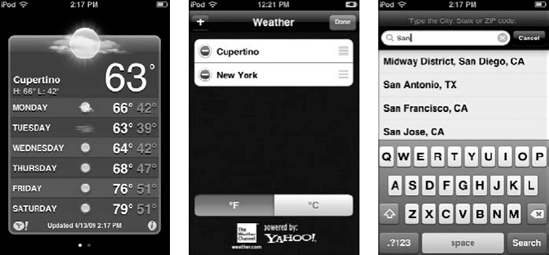
Figure 21-11. Tap the i button in Weather (left) to view the list of cities (center) and to add another city (right).
Tap the Done button in the upper-right corner of the Weather screen to finish adding cities and see the weather display for your city.
To switch from one city to the next, flick your finger over the city weather display horizontally or tap the tiny white buttons at the bottom of the city weather display (refer to Figure 21-11, left side).
You can check your financial stocks, funds, and indexes with your iPod touch or iPhone as long as it's connected to the Internet. (Whether the news is good or bad, you can quickly e-mail your broker — see Chapter 20.)
Tap Stocks on the Home screen. The Stocks app displays a few stocks and indexes you may be interested in (such as Apple and Google), and it shows updated quotes (although quotes may be delayed by up to 20 minutes). Scroll the Stocks list by dragging or flicking it with your finger.
Swipe the lower section of the Stocks screen to see either a summary, a graph (as shown in Figure 21-12, left side), or the latest news. To see a current graph of the stock, swipe the lower section to the center and tap the 1d (one day), 1w (one week), 1m (one month), 3m (three months), 6m (six months), 1y (one year), or 2y (two years) button above the graph in the stock reader. Tap the change number next to each stock to switch to show the percentage change, the market capitalization, or the change in price.
Of course, you'll want to add your portfolio to Stocks. To add a stock, index, or fund to watch, here's what you do:
Tap the i button in the lower-right corner of the stock reader, as shown in Figure 21-12 (left side).
Tap the plus (+) sign in the upper-left corner of the Stocks screen (Figure 21-12, center).
The Add Stock field appears with the keyboard (Figure 21-12, right side).
Enter the stock symbol or company name (or index or fund name).
As you type, suggestions appear below in a list.
Choose one of the suggestions or continue typing the symbol or name and then touch Search.
The stock, fund, or index you chose appears in the list on the Stocks screen, with a circled minus (−) sign next to it on the left and three horizontal gray bars on the right.
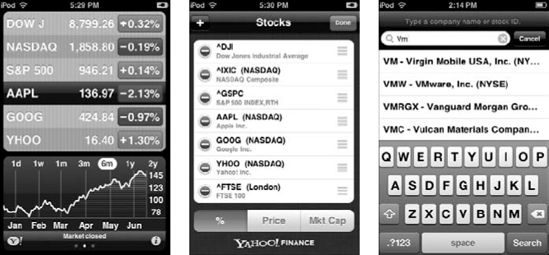
Figure 21-12. Touch the i button in Stocks (left) to view the list (center) and to add another stock, fund, or index (right).
Tip
At this point, if you want to add more stocks, funds, or indexes, tap the plus (+) sign in the upper-left corner again. To reorder a list of stocks, drag the three gray bars next to a stock to a new place in the list.
To delete a stock, tap the circled minus sign next to the stock name (refer to Figure 21-12, center) to show the Delete button. Then tap the Delete button to delete it (or tap the circled minus sign again to leave it alone).
Tap the Done button in the upper-right corner of the Stocks screen to finish adding stocks and see the stock reader.
An iPod touch can record audio through an external microphone (such as the Apple Earphones with Remote and Mic), while an iPhone can use either the external mic or its built-in mic. An iPod nano can record voice memos using its built-in mic on the back next to the video camera, or using an iPod nano–compatible microphone. An iPod classic can record voice memos using the optional Apple Earphones with Remote and Mic or an iPod classic-compatible microphone. You can find external mics for purchase at the Apple Store.
Voice memos can be up to two hours long. If you record for more than two hours, your iPod or iPhone automatically starts a new voice memo to continue your recording. After syncing with iTunes (as I describe in Chapter 9), the voice memos appear in the Music section of your iTunes library and in the Voice Memos playlist (created for you if you don't already have one).
The Voice Memos app lets you record audio through an external microphone (such as the Apple In-Ear Headphones with Remote and Mic) connected to an iPod touch or iPhone, or through the internal microphone of an iPhone. You can then send recordings to others by e-mail (or by text message on an iPhone, if your account with your carrier supports MMS), or sync them back to your computer's iTunes library.
To start recording, tap the Voice Memos app on the Home screen and then tap the red dot button on the left side of the VU meter on the microphone recording screen. (You can also press the center button on the control capsule of the Apple In-Ear Headphones to start recording.) The red dot changes to a Pause button, as shown in Figure 21-13 (left side), and the list button on the right side of the VU meter changes to a Stop button. Tap the Pause or Stop button to stop recording.
Tap the list button on the right side of the VU meter to see the Voice Memos screen with your list of recordings, as shown in Figure 21-13 (middle). Select a recording, and you can then tap Share to send it by e-mail, or Delete to delete it. After tapping Share, tap Email Voice Memo to open a new e-mail message with the recording (or tap Cancel). See Chapter 20 for details on sending an e-mail.
You can also tap the Play/Pause button on the left of the recording to play it, and tap the right arrow on the far right side of the recording to open the Info screen for that recording, as shown in Figure 21-13 (right side).
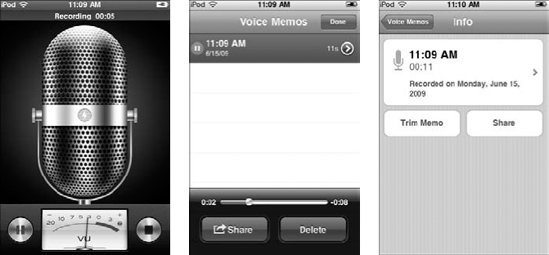
Figure 21-13. Record your voice (left), select a saved recording (middle), and open the Info screen (right).
The Info screen also lets you trim the recording so that it's shorter — tap Trim Memo to view the playback timeline, as shown in Figure 21-14, and tap along the timeline to set a stop time. Then tap Trim Voice Memo (or Cancel to cancel).
Touch Voice Memos in the upper-left corner of the Info screen to return to the Voice Memos screen, and tap Done in the upper-right corner to return to the microphone recording screen.
The Voice Memos Extra in your iPod nano or iPod classic lets you record voice memos through an external mic or, in the case of the iPod nano, through the internal mic. (Be careful not to block the mic, which is on the back.) To record voice memos with an iPod classic, first connect the Apple Earphones with Remote and Mic, or connect an external mic to the Dock connection — you won't see a Voice Memos menu item if you've never connected a mic to the iPod classic.
To start recording with an iPod nano, choose Extras
To start recording with an iPod classic, choose Voice Memos
Tip
You can set a chapter mark in your voice memo on an iPod nano to go back to that section quickly. While recording, press the Select button whenever you want to set a chapter mark. During playback, you can go directly to the next chapter by pressing the Next/Fast-forward button. Press Previous/Rewind once to go to the start of the current chapter, and twice to go to the start of the previous chapter.
To play or delete a recording on an iPod nano, choose Extras
To play a recording on an iPod classic, choose Extras
Connecting socially on a digital network isn't new — I connected to friends way back in the pre-Internet dark ages by using exotic-sounding networks such as Usenet, bulletin board systems (BBS), The Source, CompuServe, the WELL (Whole Earth 'Lectronic Link), and EIES (Murray Turoff's server-based Electronic Information Exchange Service). What's new is that more sophisticated social networks have appeared and gone mainstream very quickly, with MySpace, Facebook, and Twitter leading the pack.
You can use your iPod touch or iPhone to stay in touch with your connections on these and many other social networks on the Internet — viewing and typing messages, chatting, uploading and sharing photos, joining groups, and so on.
Facebook is the fastest-growing free-access social networking site as of this writing, with more than 200 million active users worldwide. If you're one of them (as I am), you already know that you can add friends, send them messages, and update your personal profile with photos, videos, links, and all sorts of Facebook widgets that extend the service's functions. Although you can do all this using a browser on your computer and using Safari on your iPod touch or iPhone, the site itself is far too cumbersome for easy access that way. What's needed is a "baby Facebook" on the iPod touch or iPhone.
And that's exactly what Facebook for iPhone is: This app — which also runs on the iPod touch — lets you check your friends' status updates and photos, start a conversation in Facebook Chat, and upload images from your iPod touch or iPhone.

Figure 21-15. Log in to your Facebook account (left) to see your Facebook home news feed (center) and more choices (right).
After logging in, the Facebook app remembers your username and password so that you don't have to type them to log in again. (Of course, that means if anyone grabs your iPod touch or iPhone, they'll have access to your Facebook account — use a passcode to lock up your iPod touch or iPhone, as I describe in Chapter 4, so that no one can use it without the passcode.) If you don't want the Facebook app to remember your login info, tap the Logout button in the upper-right corner of Facebook's icons screen (refer to Figure 21-15, right side).
Along the bottom of the Facebook screen are the Home icon for returning to the Home screen, the profile icon (with your first name) for showing your profile, the Friends icon to access a list of your Facebook friends, and the Inbox icon to check your messages. You can also Chat to chat directly with any of your friends who are online.
The Facebook app even lets you upload and share photos: Tap the Photos icon and add a new album (type its name and description). You can then tap the camera icon in the upper right corner of the album's screen, and choose Take Photo to snap a photo (iPhone only) or Choose From Library to pick a photo from your iPod touch or iPhone photo albums.
So MySpace, owned by Fox Interactive Media, was the most popular mainstream social networking site until Facebook came along. Today, it's the number-two service, and it's still an awesomely huge network. MySpace focuses on music, movies, and TV shows — just about every band in the universe has a MySpace page, and it's easy to add music to your profile.
You can use Safari on your iPod touch or iPhone to access MySpace, but like most social networks, the home page you see is far too cumbersome for easy access that way. The MySpace Mobile for iPhone app is much easier to use and works fine on your iPod touch as well. It lets you send and receive messages, check status updates and photos, stay up to date on bulletins, and upload images from your iPod touch or iPhone.
After you log in, your MySpace Home screen appears, as shown in Figure 21-16 (right side), with menu selections for viewing and editing your profile, checking the status and mood messages from your friends, checking friend updates, adding comments, reading bulletins, reading blogs, and changing your settings.
Along the bottom of the MySpace screen are the Home icon for returning to the Home screen, the Mail icon to check your messages, the Requests icon to view and respond to requests, the Friends icon for a list of your MySpace friends, and the Photos icon to upload photos to your MySpace page. To add photos, tap the Photos icon to see the photos already on your MySpace page and then tap the Add Photos button. You can then snap a photo (iPhone only) or pick a photo from your iPod touch or iPhone photo albums.
The most talked-about newcomer to the social network scene is Twitter, a free social messaging utility for staying connected with people in real time. With Twitter, you can post and receive messages that are 140 characters or less — called tweets. All public tweets are available to read on the public timeline, or you can read just the ones posted by the Twitter members you follow. You can post a tweet that can be read by all your followers and by anyone reading the public tweets.
Members use Twitter to organize impromptu gatherings, carry on a group conversation, or just send a quick update to let people know what's going on. Companies use Twitter to announce products and carry on conversations with their customers. You can use Safari on your iPod touch or iPhone to access Twitter, but there are alternatives that offer a better Twitter experience on your iPod touch or iPhone.
For example, you can use the Twitter for iPhone Web service (http://twitterforiphone.com) with your iPod touch or iPhone to easily flip through all your messages with the flick of a finger. Twitter for iPhone offers a menu, as shown in Figure 21-17 (left side), for checking recent posts, updating your status, sending direct messages and replies to others on Twitter, browsing friends, and adding new friends (called followers).
And wherever you go, "tweetness follows." Twitterific taps into the location services of your iPod touch or iPhone so that with your permission, it can let your followers know where you are and let you know when your followers are posting from a nearby location. You can set options for viewing messages, optimize the interface for left-handed operation, and use its own mini-browser to view linked Web pages without having to quit the app and run Safari. You can also copy a link to the last-opened Web page in Safari on your iPod touch or iPhone into a tweet — a very useful trick if you like to include Web links with your tweets. Tweet dreams!

